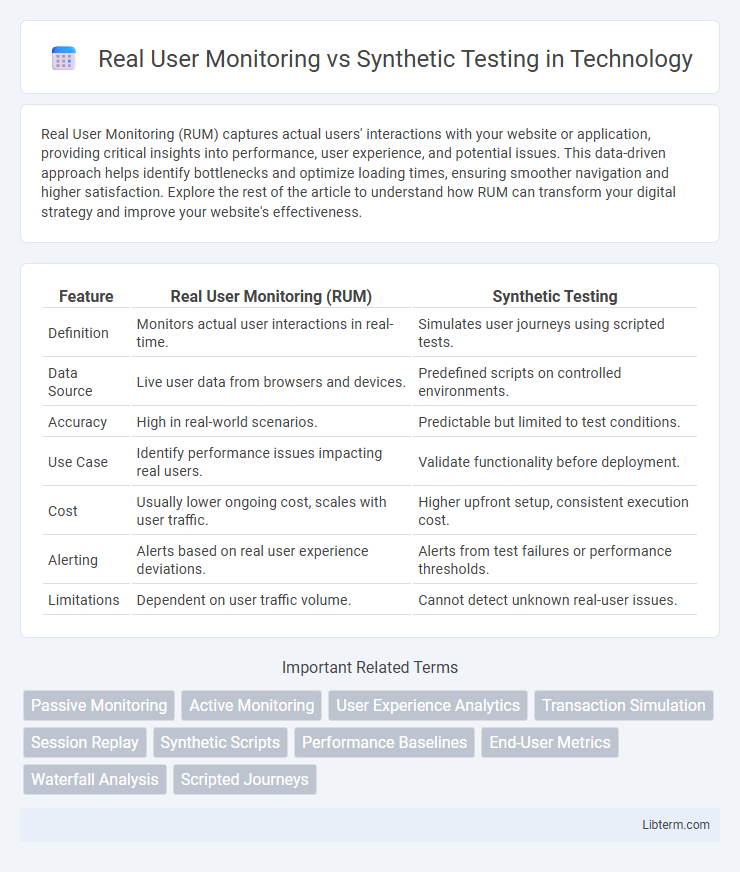Real User Monitoring (RUM) captures actual users' interactions with your website or application, providing critical insights into performance, user experience, and potential issues. This data-driven approach helps identify bottlenecks and optimize loading times, ensuring smoother navigation and higher satisfaction. Explore the rest of the article to understand how RUM can transform your digital strategy and improve your website's effectiveness.
Table of Comparison
| Feature | Real User Monitoring (RUM) | Synthetic Testing |
|---|---|---|
| Definition | Monitors actual user interactions in real-time. | Simulates user journeys using scripted tests. |
| Data Source | Live user data from browsers and devices. | Predefined scripts on controlled environments. |
| Accuracy | High in real-world scenarios. | Predictable but limited to test conditions. |
| Use Case | Identify performance issues impacting real users. | Validate functionality before deployment. |
| Cost | Usually lower ongoing cost, scales with user traffic. | Higher upfront setup, consistent execution cost. |
| Alerting | Alerts based on real user experience deviations. | Alerts from test failures or performance thresholds. |
| Limitations | Dependent on user traffic volume. | Cannot detect unknown real-user issues. |
Introduction to Real User Monitoring and Synthetic Testing
Real User Monitoring (RUM) captures genuine user interactions and performance data in real-time, providing insights into actual user experiences across various devices and network conditions. Synthetic Testing simulates user transactions through scripted tests to proactively identify performance issues and ensure application uptime without relying on real user activity. Combining RUM and Synthetic Testing enables comprehensive performance analysis by addressing both real-world user behavior and controlled, repeatable scenarios.
Key Differences Between Real User Monitoring and Synthetic Testing
Real User Monitoring (RUM) captures actual user interactions and provides insights into real-world performance, user experience, and behavior across diverse devices and locations. Synthetic Testing uses simulated transactions to proactively identify performance issues and validate application availability under controlled conditions without relying on real users. While RUM offers valuable data on user impact and variability, Synthetic Testing excels in early detection of problems and benchmarking system performance consistently.
How Real User Monitoring Works
Real User Monitoring (RUM) collects performance data directly from users' interactions by embedding lightweight JavaScript in web applications, capturing metrics like page load times, errors, and user behavior in real-time. This method enables detailed insights into actual user experiences across various devices, browsers, and network conditions. RUM's data-driven approach helps identify performance bottlenecks and optimize website responsiveness based on authentic usage patterns.
How Synthetic Testing Operates
Synthetic testing operates by simulating user interactions with applications through scripted transactions executed at regular intervals from various global locations. These tests proactively identify performance bottlenecks, uptime issues, and functional errors before real users are impacted. By generating consistent, controllable data, synthetic testing enables continuous monitoring without relying on actual user traffic.
Core Benefits of Real User Monitoring
Real User Monitoring (RUM) provides actionable insights by capturing actual user interactions with websites or applications, allowing businesses to identify real-world performance issues and user experience bottlenecks. It delivers precise data on load times, error rates, and user behaviors across diverse devices, browsers, and network conditions, enabling targeted optimizations that enhance customer satisfaction. Unlike Synthetic Testing, which simulates user actions, RUM offers continuous and comprehensive visibility into live traffic, driving data-driven decisions for improving application reliability and performance.
Advantages of Synthetic Testing
Synthetic testing provides continuous, proactive monitoring of application performance by simulating user interactions from multiple geographic locations, enabling early detection of issues before real users are impacted. It allows precise control over test conditions, ensuring consistent, repeatable results that help identify performance bottlenecks and downtime periods. Unlike Real User Monitoring, synthetic testing generates data even during low or zero user traffic, ensuring comprehensive coverage and alerting capabilities.
Use Cases: When to Choose RUM or Synthetic Testing
Real User Monitoring (RUM) excels in capturing actual user interactions, making it ideal for diagnosing performance issues in live environments and understanding user experience trends across diverse devices and locations. Synthetic Testing simulates user journeys with predefined scripts, proving invaluable for proactive monitoring, regression testing, and identifying potential bottlenecks before releasing new features or updates. Selecting RUM suits scenarios needing real-time insights into user behavior, while Synthetic Testing fits best for continuous integration workflows and controlled environment validations.
Combining Real User Monitoring and Synthetic Testing
Combining Real User Monitoring (RUM) and Synthetic Testing delivers comprehensive performance insights by capturing actual user experiences alongside simulated scenarios to identify potential issues before users encounter them. RUM provides data on diverse user environments and real-time behavior, while Synthetic Testing offers controlled, repeatable tests for proactive analysis. Integrating these approaches enhances website reliability, optimizes load times, and ensures consistent user satisfaction across different devices and network conditions.
Common Challenges and Limitations
Real User Monitoring (RUM) faces challenges such as capturing accurate data across diverse browsers and devices, dealing with incomplete user sessions, and addressing privacy concerns related to user data collection. Synthetic Testing, while controlled and consistent, is limited by its inability to replicate the full spectrum of real user behaviors and environmental variables, leading to potential gaps in identifying issues experienced by actual users. Both methods often require integration with other tools for comprehensive performance insights, as RUM struggles with proactive issue detection and Synthetic Testing cannot measure real-time user interactions or network conditions.
Choosing the Right Solution for Your Website
Real User Monitoring (RUM) captures actual user interactions and performance data, providing insights based on real traffic patterns and behaviors, essential for understanding authentic user experience. Synthetic Testing simulates user activity through scripted scenarios, offering controlled, repeatable performance assessments and proactive issue detection. Selecting the right solution depends on whether you prioritize real-time user feedback to identify live problems or need consistent, predictable testing to preemptively monitor and improve website performance.
Real User Monitoring Infographic

 libterm.com
libterm.com